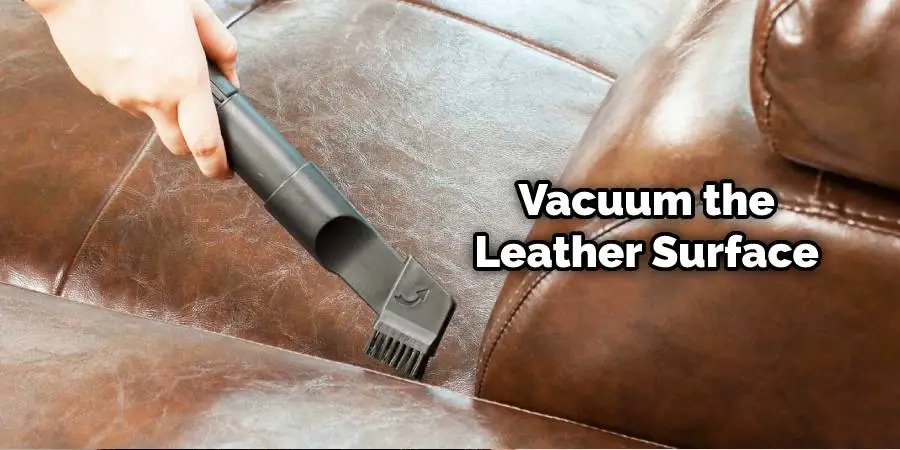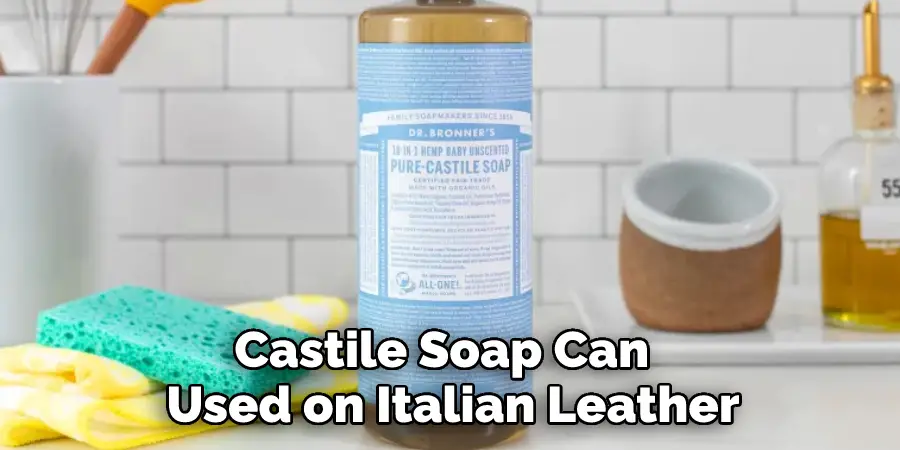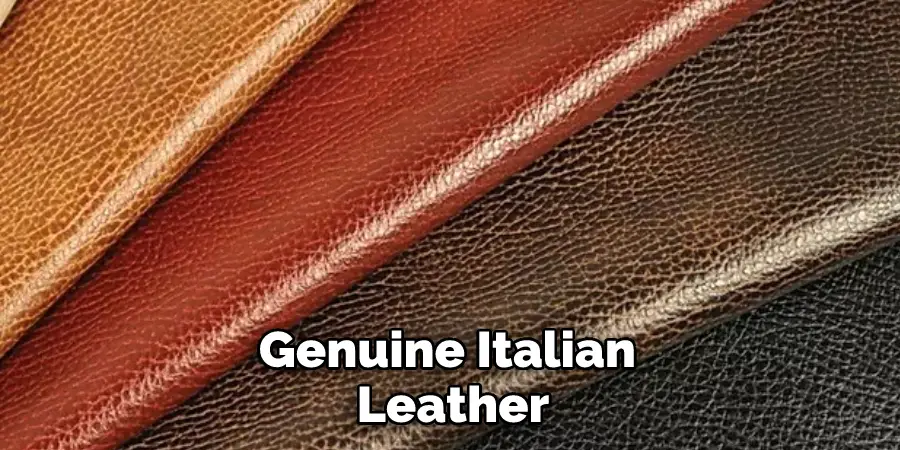If you own Italian leather furniture, you know how luxurious and beautiful it is. But you also know that it requires special care to keep it looking its best. Here are some ways how to clean Italian leather so that your furniture can stay in pristine condition for years to come. Keep reading.

Italian leather is a high-quality material known for its durability and beauty. However, it’s essential to clean it properly to protect it from dirt and dust. Many people mistake using cleaning products that are too harsh and end up damaging their furniture. It’s essential to use the right products and clean your furniture gently to avoid any damage.
Summary: Cleaning Italian leather requires taking a few different steps, such as removing dust with a soft bristle brush or vacuum cleaner, spot cleaning with a damp cloth, and specialized cleaners for tougher stains. For tougher scuff marks, use an eraser on the underside of the leather. Lastly, condition the leather to prevent cracking and keep the material looking its best.
What’s the Difference Between Leather and Italian Leather?
There are many types of leather, but Italian leather is prized for its luxurious feel and high quality. Often used in high-end furniture and fashion, Italian leather comes at a higher price tag than other types of leather. But what exactly is the difference?
Italian leather is made from full-grain cowskin that has been treated with natural oils and waxes. This gives it a soft, supple texture that is also highly durable. In addition, full-grain leather is the highest quality available, as it has not been sanded or buffed to remove imperfections. Instead, these natural markings add character and unique beauty to each piece of Italian leather.
When shopping for Italian leather furniture or clothing, look for the label “Vero cuoio,” which means “true leather.” This guarantees that you are getting a product made with genuine Italian leather.
How to Clean Italian Leather Detailed Guide
Way 1: Use Brush and Vacuum
What You’ll Need:
- A vacuum cleaner with a brush attachment
- A soft-bristled brush, such as a horsehair brush or a clean toothbrush
- Mild soap, such as dishwashing liquid
- Water
Vacuum the leather surface to remove any dirt or dust. If the dirt is particularly stubborn, you may need to use the brush attachment on the vacuum cleaner. Mix a small amount of mild soap with some water to create a sudsy solution.

Dip the brush’s bristles into the sudsy solution and scrub at the leather surface to remove any dirt or stains. Rinse the area with clean water and pat it dry with a towel. Vacuum the area again to remove any soap residue. Apply a leather conditioner to the area if it looks dry or stiff.
Way 2: Use Soap and Conditioner
What You’ll Need:
- Bucket
- Warm water
- Mild dish soap or baby shampoo
- Soft cloths or a sponge
- Leather conditioner
If you want to use a more traditional method, mix a small amount of soap with water. Ensure the soap is very mild, as anything too harsh will damage the leather. Next, apply the mixture to a clean cloth and rub it into the leather circular motion. Once you’ve gone over the entire piece, rinse off the soap with another clean cloth dampened with water.
After washing, apply a conditioner to help keep the leather soft and supple. You can find conditioners specifically for leather at most stores that sell cleaning supplies. Apply the conditioner according to the package directions and buff it into the leather with a clean cloth. Allow it to sit for a few minutes before wiping off any excess.
Way 3: Use Lemon Juice and Cream of Tartar
What You’ll Need:
- 1/2 cup lemon juice
- 1/4 cup cream of tartar
- 1 gallon warm water
- Bucket
- Sponge
Start by mixing the lemon juice, cream of tartar, and warm water in a bucket. Next, dip a sponge into the mixture and use it to scrub the leather in a circular motion gently. Allow the solution to sit on the leather for about 15 minutes before rinsing it off with clean water. Finally, allow the leather to air dry completely.
Additional Tips:
-Never use harsh chemicals or cleaners on Italian leather. This will damage the material and ruin its appearance.
-Always test any cleaner on an inconspicuous area of the furniture before using it on the entire piece. This will help you avoid any damage.
-Leather should be conditioned regularly in order to keep it looking its best. You can find leather conditioners at most stores that sell cleaning supplies.
Note: This method is not recommended for suede or nubuck leather, as it can damage the surface.
Way 4: Use Water and Vinegar
What You’ll Need:
- ½ cup white vinegar
- 2 cups water
- Sponge
- Soft cloth
Mix the vinegar and water in a bowl or spray bottle. Spray or sponge the solution onto the leather surface. Wipe with a soft cloth until the leather is dry.
You Can Check It Out to Make an Old Baseball Glove Look New

Italian leather is a luxurious material that can last for years with proper care. Using this simple cleaning method, you can keep your Italian leather looking its best. Vinegar is a natural cleaner that will remove any dirt or oils from the surface of the leather. Be sure to rinse the area with clean water to remove any vinegar residue. This is a safe and effective way to clean your Italian leather furniture or accessories.
Way 5: White Vinegar With Linseed Oil
What You’ll Need:
- 1/4 cup white vinegar
- 3 tablespoons linseed oil
- Warm water
- Glycerin (optional)
Combine the white vinegar and linseed oil in a bowl. You can add a few drops of glycerin if you want to create a shiny finish. Dip a clean, soft cloth into the mixture and rub it onto the leather in a circular motion. Continue until the entire surface is covered. Wipe away any excess with a dry cloth. Allow the leather to air dry completely before using it again.
This method is suitable for cleaning and conditioning your Italian leather simultaneously. The vinegar will remove any dirt or grime, while the linseed oil will help to prepare and protect the leather.
Tips to Maintain Italian Leather
- Keep your Italian leather dry and away from direct sunlight to avoid cracking, fading, or discoloration.
- Use soft, damp cloths for cleaning leather instead of chemical cleaners, which may damage the leather’s finish.
- Condition your leather regularly with a leather-specific conditioner to keep it soft and supple.
- If possible, store your Italian leather items in warm and dry spaces when not in use.
- Avoid exposing Italian leather products to temperatures above 95 degrees Fahrenheit as it can cause serious damage.
Frequently Asked Questions
Does Italian Leather Scratch Easily?
The condition of your Italian Leather may vary depending on a number of factors, such as the care and treatment you give it, the environment it’s kept in, and the individual characteristics of your leather. That said, most Italians would generally say that Italian Leather is known for its high quality and resilience to scratches, so unless you’re really rough with your leather goods, you should be fine.
Is Italian Leather Easy to Clean?
While Italian Leather is definitely a luxurious material, it is also very easy to clean. All you need are some warm soapy water and a soft cloth to get the dirt and dust off. You can use this cleaner on any type of leather – saddlebags, motorcycle seats, or even your keyboard!
What is the Best Cleaner for Italian Leather?
When it comes to cleaning Italian leather, a natural cleaner is the best option. This type of cleaner is made using ingredients that are safe for your skin and will not leave behind any residues or chemicals. Some natural cleaners that work well on Italian leather include citrus juice, vinegar, water, clay powder (for deep-seating dirt), and essential oils ( such as lavender).
Castile soap can also be used on Italian leather if you want an effective chemical-free clean. However, keep in mind that this type of soap can sometimes strip the finish off your leather goods so be sure to test a small section first before proceeding with full cleanses.

Once you’ve chosen a natural cleaner or castile soap®, follow these simple steps: wet down your item with just enough water to moisten but not soak; pour in the desired amount of cleaner; agitate until combined; rinse thoroughly with fresh water. Always remember to wear acid-resistant gloves while cleaning!
What Happens if Italian Leather Gets Wet?
Italian leather is notorious for its durability and water resistance, which makes it a great choice for items such as wallets, purses, and laptop cases. However, if Italian leather gets wet, there are some things that you need to know in order to prevent damage.
First of all, always keep your Italian leather dry by storing it in an airtight container or bag. If necessary, place it inside a plastic wrap before placing it back into the storage box. Secondly, avoid putting your Italian leather products in direct contact with water or other liquids – this includes rainwater and pool water! Finally, 、 make sure not to rub the surface too vigorously; this will only cause scratches that can later become cracks.
Is Genuine Italian Leather Good?
While genuine Italian leather is considered to be of high quality, there are many factors that you need to consider before making a purchase. One of the most important things to look for is the quality of the hide. If it has been treated with harmful chemicals or other toxins, then it will not be suitable for use in luxury goods like bags and shoes. Additionally, make sure that the tanning process used to produce the leather is done using natural ingredients rather than artificial dyes or solvents.

When it comes to materials and construction, authentic Italian leather is often made from top-quality calfskin that has been tanned using only vegetable oils and waxes. This results in a durable finish that doesn’t fade or crack over time. When shopping for genuine Italian Leather products, make sure to read reviews and compare prices so you can get the best deal possible!
Conclusion
To clean your Italian leather, you will need a few simple items found in most households. The following steps will help you remove dirt, oils, and other blemishes from your furniture. Before cleaning the entire piece, be sure to test this process on an inconspicuous area. We hope you find this article on how to clean italian leather helpful. Thanks for reading!
You may also like – How to fix over conditioned leather.

